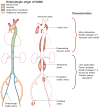Understanding the pathogenesis of abdominal aortic aneurysms
- PMID: 26308600
- PMCID: PMC4829576
- DOI: 10.1586/14779072.2015.1074861
Understanding the pathogenesis of abdominal aortic aneurysms
Abstract
An aortic aneurysm is a dilatation in which the aortic diameter is ≥3.0 cm. If left untreated, the aortic wall continues to weaken and becomes unable to withstand the forces of the luminal blood pressure resulting in progressive dilatation and rupture, a catastrophic event associated with a mortality of 50-80%. Smoking and positive family history are important risk factors for the development of abdominal aortic aneurysms (AAA). Several genetic risk factors have also been identified. On the histological level, visible hallmarks of AAA pathogenesis include inflammation, smooth muscle cell apoptosis, extracellular matrix degradation and oxidative stress. We expect that large genetic, genomic, epigenetic, proteomic and metabolomic studies will be undertaken by international consortia to identify additional risk factors and biomarkers, and to enhance our understanding of the pathobiology of AAA. Collaboration between different research groups will be important in overcoming the challenges to develop pharmacological treatments for AAA.
Keywords: animal models; doxycycline; embryologic origin; epigenetics; extracellular matrix; genetic susceptibility; inflammation; matrix metalloproteinases; risk factors; smoking.
Figures



Comment in
-
Abdominal aortic aneurysms: do not underestimate the role of diabetes.Expert Rev Cardiovasc Ther. 2015 Dec;13(12):1289-90. doi: 10.1586/14779072.2015.1100537. Epub 2015 Oct 10. Expert Rev Cardiovasc Ther. 2015. PMID: 26456049 No abstract available.
-
In response: abdominal aortic aneurysms: do not underestimate the role of diabetes.Expert Rev Cardiovasc Ther. 2015 Dec;13(12):1291-2. doi: 10.1586/14779072.2015.1100538. Epub 2015 Oct 15. Expert Rev Cardiovasc Ther. 2015. PMID: 26469388 No abstract available.
References
-
- Larsson E, Granath F, Swedenborg J, Hultgren R. More patients are treated for nonruptured abdominal aortic aneurysms, but the proportion of women remains unchanged. J Vasc Surg. 2008;48(4):802–807. - PubMed
-
- Olsson C, Thelin S, Stahle E, Ekbom A, Granath F. Thoracic aortic aneurysm and dissection: increasing prevalence and improved outcomes reported in a nationwide population-based study of more than 14,000 cases from 1987 to 2002. Circulation. 2006;114(24):2611–2618. - PubMed
-
- Kent KC. Clinical practice. Abdominal aortic aneurysms. N Engl J Med. 2014;371(22):2101–2108. - PubMed
-
- Jongkind V, Yeung KK, Akkersdijk GJ, et al. Juxtarenal aortic aneurysm repair. J Vasc Surg. 2010;52(3):760–767. - PubMed
Publication types
MeSH terms
Grants and funding
LinkOut - more resources
Full Text Sources
Other Literature Sources
